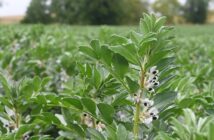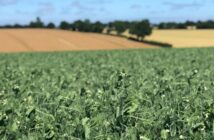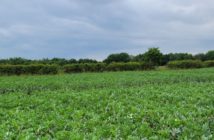“Early indications for the pulse harvest are in line with the early cereal and oilseed rape crops, with 2016 looking like a significantly lower yielding year than 2015,” comments Roger Vickers, Chief Executive of PGRO. “The 2015 pulse harvest was significantly above average, and with growers possibly anticipating around 20% less than the norm in 2016, the performance year on year may vary widely. The generally cold and wet spring – broken by a short heat wave in early July before returning to cool and damp – is believed to have been the general cause. Only in August has the country seen a prolonged warm drier spell that was too late to help yields.”
Early pea quality is reported as variable. Those seen so far have been generally good, with the usual early post-harvest issues affecting soakability negatively affecting value, although these are often ameliorated by storage.
Early winter bean samples by contrast have often been poor with mall grain size, shrivelled skin texture and surface staining – fit only for feed. However, as always, there are also reports of good yield and quality. Growers who remained on top of disease have generally fared better with more visually impressive samples and yields averaging around 5t/ha.
With spring bean harvest barely underway it is far too early to comment on total availability or to assess UK quality from 2016, although very early crops are reported at around 5t/ha with small grains.
September will see the publication of the DEFRA June survey and give the best guidance we have to the total crop area sown to pulses in 2016.
Chris Collings, President of BEPA, comments that the Australian harvest of 2015 was the largest to date with excellent yields. This and good prices has encouraged growers to stick with the crop and a similar area of almost 290,000ha is in production for 2016, with South Australia and Victoria being the leading states for production. Early indications were promising for growers and optimism remains high for another large crop.
Canadian harvest of peas is anticipated to be up to 20% larger than 2015 and this is expected to continue to put downward pressure on prices once crop outturn is fully understood.
Baltic origin bean crops were reported in good heart and it is believed that quality will again be good, putting this source in direct competition with the UK and Australia for the export market.
France continues to report poor quality beans, but their pea production has been significantly better, particularly in the south. Production areas in the north have been compromised by disease control issues exaggerated by the wet weather conditions throughout the season.
Feed beans continue to be valued at circa £145-150/t ex farm keeping in line with the base feed wheat price. This is likely to come under pressure as growers seek to offload early crops to feed, but there has been little trading activity ahead of the main harvest. Demand from the UK feed industry remains enthusiastic. A significant amount of their requirement has been covered as they aim to ensure continuity of supply.
Human Consumption beans are trading at a premium of £25 over feed beans, there is again little movement.
The main Egyptian market remains strapped for cash, despite a 13% devaluation in the Egyptian Pound in the spring, and pundits are forecasting a further devaluation as likely. A 15% fall in the value of Sterling since this time last year will assist in UK exports versus the competition, but buyers need to emerge. Exports are likely to be slow to get going. The priority for Egypt’s currency managers is their demand for almost 12 million tonnes of imported wheat in the coming year.
Demand from the Sudan (a much smaller market) is being negatively affected by their continued access to old crop which will ease in the coming weeks.
Turning to combining peas, the general view for marrowfats was that the crop 2016 was mostly already wrapped up in contracts prior to harvest. There are, however, early indications that some free market productions are being offered. There is currently little market for additional availability and sellers might anticipate lower valuations than those produced on contracts agreed before sowing. Nominal values for free market productions are circa £235/t depending upon location and assuming good quality.
Large blue pea yields have been slightly better than marrowfats and the weaker sterling values have helped increase export enquiries. With no carryover of any significance, new crop values are better than the old. Circa £200/t ex could be expected for top samples for human consumption, with £15 discount for micronising feed business.
Yellow peas remain of relatively high value – similar to the large blues – but this is considered highly likely to be temporary bearing in mind the anticipated size of the Canadian crop.



